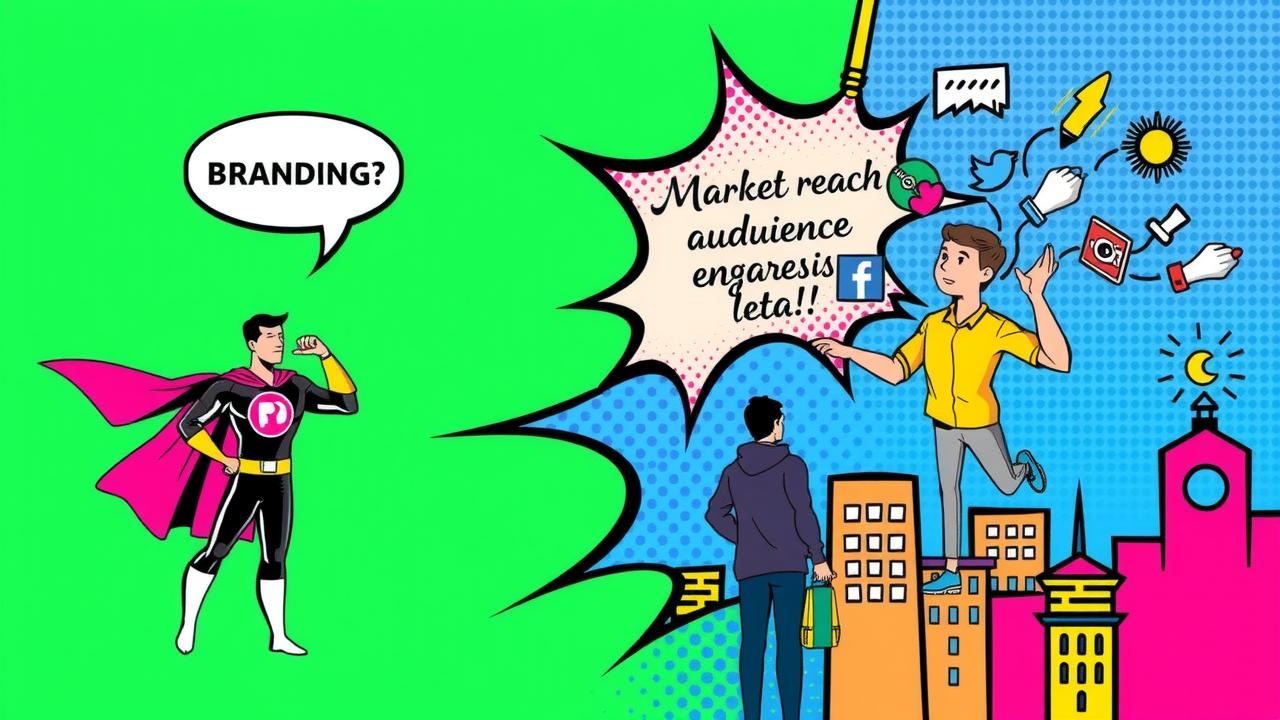Table of Contents
- Understanding Branding and Marketing\
1.1. What is Branding?\
1.2. What is Marketing?\
1.3. Core Objectives of Branding and Marketing\
1.4. Focus Areas: Branding vs Marketing\
1.5. Key Components of Branding and Marketing\
1.6. Timeframe: Long-term vs Short-term\
1.7. Measuring Success in Branding and Marketing\
1.8. The Interrelationship Between Branding and Marketing\
1.9. Real-world Examples of Branding and Marketing\
1.10. Final Thoughts on Branding and Marketing - Frequently Asked Questions\
2.1. What’s the main difference between branding and marketing?\
2.2. Can you give me examples of branding and marketing?\
2.3. Why is branding important for my business?\
2.4. How does branding impact marketing efforts?\
2.5. Can a business have great branding but poor marketing? - TL;DR
Understanding the nuances between branding and marketing is essential for any business. Branding is all about crafting a unique identity—think logos, names, and messaging—that helps shape how customers perceive you. It’s not just surface-level; it’s about building trust and forming long-lasting relationships. On the flip side, marketing dives into promoting your products or services to entice buyers, often through strategic campaigns and research. While branding focuses on your business’s long-term vision, marketing aims for short-term wins like increasing sales. Both are interconnected; strong branding enhances marketing efforts while effective marketing boosts brand recognition. Understanding this balance can propel your business forward!
1. What is Branding?
Branding is all about creating a unique identity for a business or product. Think of it as the personality of your company. It includes elements like the name, logo, design, and messaging that help shape how people perceive your brand. It’s not just about what you sell; it’s about how you connect with your customers on an emotional level. For example, when you see the golden arches of McDonald’s, it brings to mind not just fast food, but a sense of familiarity and comfort. That’s branding at work! It aims to establish a distinct presence in the market, building loyalty among customers who resonate with the brand’s values and story. Good branding creates a relationship with customers, making them feel more than just a transaction—they become part of a community.
2. What is Marketing?
Marketing is all about promoting and selling products or services. It includes a range of activities like market research, advertising, and sales strategies aimed at reaching potential customers. The primary goal is to persuade them to buy what you’re offering. Think of marketing as the bridge that connects your product to the consumer. For example, if you’re launching a new smartphone, your marketing efforts might include social media ads, email campaigns, and promotional discounts to entice buyers. It’s a dynamic field, often focused on short-term strategies to drive immediate sales and meet business objectives. Unlike branding, which establishes long-term identity, marketing adapts quickly to changing trends and consumer behavior, making it essential for achieving quick wins in the marketplace.
3. Core Objectives of Branding and Marketing
Branding and marketing serve distinct but complementary purposes within a business. The core objective of branding is to create a unique identity and foster a deep emotional connection with customers. It’s not just about what you sell, but how your brand makes people feel. For instance, think about Nike. Their branding focuses on inspiration and empowerment, which resonates with athletes and fitness enthusiasts alike, encouraging loyalty that goes beyond just products.
On the other hand, marketing is primarily about driving sales and promoting specific products or services. It aims to reach potential customers through targeted campaigns, whether that’s email marketing, social media ads, or promotions. A great example is a seasonal sale announcement that invites customers to take action quickly, capitalizing on urgency to boost sales.
In essence, branding lays the groundwork for how a business is perceived in the market, while marketing implements strategies to directly engage and convert that perception into sales.
| Aspect | Branding | Marketing |
|---|---|---|
| Core Objective | Establish a significant and differentiated presence to attract and retain loyal customers | Promote specific products or services to generate sales and meet business goals |
4. Focus Areas: Branding vs Marketing
Branding focuses on the long-term vision of a company, aiming to cultivate a unique identity that resonates with customers. It’s about creating an emotional connection, ensuring that every interaction with the brand leaves a lasting impression. For instance, think about Apple. Their branding goes beyond just selling tech products; it builds a lifestyle around innovation and creativity, making customers feel a part of something bigger.
On the other hand, marketing is all about immediate impact. It revolves around short-term strategies and campaigns designed to drive sales and expand market reach. Consider a limited-time offer or a seasonal sale; these tactics are crafted to prompt quick decisions from consumers and boost sales in a specific timeframe.
While branding develops the overall narrative and emotional backbone of a business, marketing distills that story into actionable strategies that attract customers and generate revenue.
5. Key Components of Branding and Marketing
Branding and marketing, while intertwined, have distinct components that serve different purposes. In branding, key components include the brand strategy, brand name, logo, design elements, and tone of voice. For instance, think about Apple; their minimalist design and innovative logo resonate with their identity of simplicity and cutting-edge technology. It’s about creating an emotional connection with customers and ensuring a consistent experience across all touchpoints.
On the flip side, marketing involves a variety of strategies that aim to promote products or services effectively. This includes advertising, promotions, public relations, digital marketing, and sales tactics. A classic example would be a seasonal sale campaign by a clothing brand, utilizing social media ads and email promotions to drive immediate sales. Here, the focus is on reaching potential customers and persuading them to take action, like making a purchase. Both areas require creativity and strategic thinking, but they operate in different realms of the business landscape.
- Brand Identity: Visual elements like logo, color scheme, and typography.
- Target Audience: Understanding who you’re speaking to.
- Messaging: The core messages that resonate with your audience.
- Positioning: How you stand out in the marketplace compared to competitors.
- Marketing Channels: Different platforms used to reach customers, such as social media, email, and ads.
- Consistency: Maintaining a cohesive look and feel across all platforms.
- Customer Experience: The overall journey a customer has with your brand.
6. Timeframe: Long-term vs Short-term
When we talk about branding, we’re diving into a long-term commitment. It’s not just about making a quick impression; it’s about building a lasting identity that resonates with your audience over time. Think of it as planting a tree. It takes years to grow, but once it’s established, it can provide shade and comfort for generations. For example, brands like Apple or Nike didn’t just pop up overnight. They’ve spent years refining their image, building trust, and creating a loyal customer base that feels a deep emotional connection to them.
On the flip side, marketing tends to be more immediate and tactical. It’s all about the here and now—promotions, campaigns, and quick wins. Marketing strategies can shift rapidly, responding to the latest trends or consumer behaviors. For instance, a limited-time discount or a holiday campaign can drive sales in a matter of weeks. While these efforts can boost revenue in the short term, they don’t necessarily shape the long-term perception of the brand.
Ultimately, understanding this difference in timeframe helps businesses navigate their strategies. Investing in branding lays the groundwork for a strong market presence, while smart marketing can drive those immediate results that keep the business thriving.
7. Measuring Success in Branding and Marketing
Measuring success in branding and marketing requires different approaches, as each serves distinct purposes. For branding, success is often gauged through metrics like brand awareness, which reflects how many people recognize and remember your brand. Customer loyalty is another crucial indicator; loyal customers not only repeat purchases but also advocate for your brand, enhancing its reputation in the market. Additionally, overall brand equity, which encompasses the value that your brand adds to your products or services, is a key measure of branding success. Companies like Apple thrive on strong brand equity, which allows them to charge premium prices.
On the marketing side, success is typically measured by tangible outcomes like sales figures, conversion rates, and return on investment (ROI) for specific campaigns. For example, if you run an online ad campaign, you would look at how many clicks it generated, how many of those clicks turned into actual sales, and the overall profit from that campaign compared to its costs. These metrics help businesses assess the effectiveness of their marketing strategies and make data-driven decisions to optimize future efforts. Together, these measurements offer a comprehensive view of how well branding and marketing efforts are performing, guiding businesses to refine their strategies for greater impact.
8. The Interrelationship Between Branding and Marketing
Branding and marketing are like two sides of the same coin, each enhancing the other in meaningful ways. Branding sets the stage by defining who you are as a business, creating a unique identity that resonates with your audience. This identity is crucial because it shapes how customers perceive your products or services. On the other hand, marketing acts as the vehicle that drives this identity forward. It uses strategies to promote your brand, ensuring that your message reaches the right people at the right time.
For instance, when a company like Nike launches a marketing campaign, it doesn’t just focus on selling shoes; it emphasizes the brand’s core values of inspiration and innovation. This connection between the campaign and Nike’s branding creates a cohesive experience for consumers, making them more likely to engage with both the marketing and the brand itself.
Moreover, strong branding can make marketing efforts more effective. When customers have a positive perception of a brand, they are more likely to respond favorably to marketing messages. Conversely, well-executed marketing strategies can enhance brand recognition and equity by consistently showcasing the brand’s qualities and values across various channels.
In essence, the interrelationship between branding and marketing is symbiotic. Effective marketing reinforces brand identity, while a strong brand provides context and meaning that enriches marketing campaigns. Understanding this relationship is vital for businesses looking to create a lasting impact in their markets.
9. Real-world Examples of Branding and Marketing
Branding and marketing come to life through real-world examples that illustrate their unique roles. Take Apple, for instance. Their branding goes beyond just selling gadgets; it creates a lifestyle. The sleek design of their products, the minimalist logo, and the aspirational messaging cultivate a sense of innovation and quality that resonates deeply with consumers. When people think of Apple, they don’t just think about phones or computers; they think about being part of a cutting-edge community.
On the marketing side, Apple’s promotional campaigns are equally powerful. Consider their annual product launches, which generate massive anticipation and media buzz. These events are carefully crafted to showcase new products and highlight their features, driving immediate sales and creating a sense of urgency among consumers. Marketing efforts like limited-time promotions or back-to-school discounts target specific demographics, pushing sales while reinforcing the brand’s presence.
Another great example is Nike. Their brand is synonymous with athleticism and motivation, embodied in the iconic “Swoosh” logo and the motivational tagline “Just Do It.” This branding evokes feelings of empowerment and determination, making consumers feel connected to the brand on a personal level.
Nike’s marketing strategies complement this branding perfectly. Their use of celebrity endorsements and social media campaigns creates a vibrant marketing ecosystem that engages their audience. The annual Nike Women’s Half Marathon, for example, not only promotes fitness but also strengthens the brand’s message of inclusivity and empowerment, bringing together a community of runners while driving sales of women’s athletic gear.
These examples highlight how effective branding creates a rich emotional landscape that allows marketing efforts to thrive. By understanding these dynamics, businesses can better navigate their own branding and marketing strategies.
10. Final Thoughts on Branding and Marketing
When we wrap our heads around branding and marketing, it’s clear that both are vital, yet they serve different purposes. Branding is that strong foundation; it’s about the story you tell and the feelings you evoke in your customers. For instance, think about Apple. Their branding creates a sense of innovation and premium quality that resonates deeply with their audience. On the other hand, marketing is the action-oriented side of the equation. It’s where you actively reach out to your customers with campaigns and promotions. When Coca-Cola runs a summer sale, that’s marketing in action, designed to boost sales in the moment.
What’s really interesting is how these two interact. Effective marketing can amplify your brand’s message, while a strong brand can make your marketing efforts more impactful. For example, a well-known brand like Nike can launch a quick promotion and see immediate results, simply because people already trust and resonate with their brand image.
So, in the end, understanding the nuances between branding and marketing is crucial. It’s not just about pushing products; it’s about building lasting relationships with your audience and creating a memorable identity that stands the test of time.
Frequently Asked Questions
1. What’s the main difference between branding and marketing?
Branding is about creating a unique identity and image for your business, while marketing focuses on promoting products or services to attract customers.
2. Can you give me examples of branding and marketing?
Sure! Branding could be a logo, a slogan, or the overall feel of your company, like how Coca-Cola makes you feel happy. Marketing could be a social media ad or email campaign that encourages people to buy a drink.
3. Why is branding important for my business?
Branding helps your business stand out from competitors and build trust with customers. A strong brand can create loyal customers who feel emotionally connected to your company.
4. How does branding impact marketing efforts?
Good branding gives your marketing a clear direction. It ensures that your advertisements and promotions reflect the values and identity of your brand, making them more effective.
5. Can a business have great branding but poor marketing?
Absolutely! A company can have a strong brand image, but if its marketing isn’t effective, it might struggle to reach its target audience or drive sales.
TL;DR Branding and marketing are distinct but interconnected concepts. Branding focuses on creating a unique identity and building customer relationships over the long term, while marketing promotes specific products or services to drive short-term sales. Effective branding enhances marketing efforts, and strategic marketing strengthens brand presence. Successful branding is measured through customer loyalty and brand awareness, whereas marketing success is evaluated through sales figures and return on investment. Understanding their differences and interdependence is crucial for businesses.



